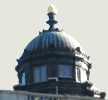You can learn historical facts about any day of the year at the Today in History Archive page.
The Library has unparalleled resources relating specifically to Gettysburg and generally to the Civil War. Many of these materials are available online. The Library's two copies of Lincoln's oratorical masterpiece, the Gettysburg Address, can be seen in the exhibition of the same name. The only known photograph of President Lincoln at Gettysburg can also be seen. A magnificent panoramic shot of the 50th reunion of the battle of Gettysburg is part of the American Memory collection "Taking the Long View: Panoramic Photographs, 1851-1991."
Other American Memory collections rich with materials relating to the Civil War are: the "African American Odyssey," "African-American Sheet Music," "Band Music from the Civil War Era," "Civil War Maps," "Selected Civil War Photographs," the "Frederick Douglass Papers," the "Abraham Lincoln Papers" and "Born in Slavery: Slave Narratives from the Federal Writers' Project, 1936-1938." And that's just a few. You can find all collections with materials relating to the period at the American Memory Collection Finder page. Scroll to the middle of the page and click on the time period 1850-1899. You'll be amazed at what you can find. American Memory contains 8 million items in more than 100 thematic collections. You can see and hear things that were once available only by visiting the Library in person.
A. "[Six officers of the 17th New York Battery]," 1863. Prints and Photographs Division. Reproduction No.: LC-DIG-cwpb-04048 DLC (b&w copy scan) LC-B8171-7559 DLC (b&w film neg.); Call No.: LC-B817- 7559.
B. Timothy O'Sullivan, photographer, "[Gettysburg, Pa. John L. Burns, the "old hero of Gettysburg," with gun and crutches, 1863." Prints and Photographs Division. Reproduction No.: LC-DIG-cwpb-01659 DLC (b&w copy scan of left half), LC-DIG-cwpb-01660 DLC (b&w copy scan of right half), LC-B8171-2402 DLC (b&w film copy neg.); Call No.: LC-B811- 2402.



